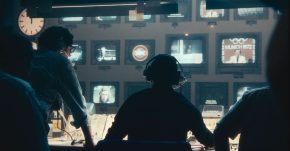Director, Guðmundur Arnar Guðmundsson [Heartstone] made a hyper-sensitive and detail-oriented coming-of-age tale. He offers a lyrical portrayal of the struggles faced by teenagers in modern society. Set in a marginalized corner of Reykjavik, Iceland, “Beautiful Beings” follows four teenage boys as they navigate the treacherous space between childhood and adulthood.
Guðmundsson immediately captivates his viewers with a wonderful, poetic opening sequence. Extreme close-ups of floating impressions and nature lay the groundwork. That poeticism lingers throughout the story. “Someone lifted me out of the sea,” the voice of a young boy tells us.
When we meet the story’s protagonist, 14-year-old Balli [Áskell Einar Pálmason] endures bullying, physical violence, and emotional torment. All this leaves him suppressed, humiliated, and filled with anger. He is constantly thrown to the wall, beaten up, his jacket stuffed into the toilet. The filmmaker’s hyper-focus on detail, from the swirls of cigarette smoke to the buzzing insects, and his use of extreme close-ups, serve as powerful storytelling tools. These sophisticated choices immerse us in Balli’s experiences and emotions.
As we delve into his life, we discover the source of his pain: his father’s tragic death due to LSD-induced delusions, his abusive stepfather, and a neglectful, drug-addicted mother. Feeling invisible and cast aside, the young boy spirals into self-destructive behavior, resorting to self-harm as an outlet for his anguish.
The other main character we follow is Addi [Birgir Dagur Bjarkason], a gifted boy raised by a clairvoyant mother, who decides to bring Balli into his gang of outsiders. As the boys are left to their own devices, they embark on a tumultuous exploration of aggression, violence, loyalty, and love.

Source: IMDB
Visually, “Beautiful Beings” employs a soft color palette, reflections, and “clean-punched” cinematography to create a visually pleasing and introspective atmosphere. At its core, the movie sheds light on the rising violence among teens in Iceland, reflecting forms of bullying, unresolved anger, and the absence of conflict resolution methods.
The filmmakers highlight how aggression becomes a default response for these young gangs, coping with difficult circumstances and low self-esteem. For instance, we witness an angry boyfriend immediately resorting to threats and physical aggression when other boys merely look at his girlfriend. As a response, the threatened boy and his friends launch a prompt attack, preventing violence with violence. Early on we can be certain, all this aggression will eventually reach a breaking point, leading to irreversible damage. Crazy parties, beatings, outbursts of aggression are just the beginning.
Guðmundsson, who also wrote the screenplay, emphasizes that growing up is not solely about reaching a certain age, but about learning to differentiate between right and wrong. Addi is the one who gets to that level the quickest.
Throughout the movie, we witness moments of power, revenge, aggression, and complex plots, reminiscent of a Shakespearean tragedy. However, amidst the darkness, “Beautiful Beings” also underlines the power of affection, friendship, and attention. These elements have the potential to provide salvation.
Members of the gangs we observe are forced to grow up too fast. They have to navigate the world with no one to turn to or rely on. The absence of decent parental examples and the prevalent abuse and neglect connect these boys, as they all bear the weight of their harsh realities. However, even if the darkness seems to prevail, there is still hope. Characters like Addi, who has faced less emotional baggage, bring goodness and light to those who are wounded.
“Beautiful Beings” raises attention to parental responsibilities and the importance of conscious choices made by adults (who act like adults). One particularly beautiful scene in the film is when the boys bathe Balli, preparing him for his first date ever. This poignant moment showcases the profound impact we can have on each other’s lives, whether it is for good or ill. “Beautiful Beings” reminds us that our actions can create miracles or inflict harm on others, emphasizing the importance of compassion and love.
The film also sheds light on the flaws within the justice system, asking difficult questions about protection and support for abused mothers and children. Do they really have someone to turn to?
As the movie progresses, reality blends with spirituality, and Addi’s visions and dreams take center stage.This poetic and otherworldly quality elevates the film, adding another layer of depth to the narrative.
The performances by the young actors in “Beautiful Beings” are phenomenal, capturing the raw emotions and complexities of their characters. The film’s pacing is well-balanced, and the dialogue is skillfully written, adding depth to the storytelling. One cannot help but wish for the script to be soon turned into a novel.
Ultimately, “Beautiful Beings” reminds us that despite their actions, these characters are just kids in need of hugs and love. This Icelandic story is a must-watch for those seeking a heartfelt and thought-provoking cinematic experience.
Watch “Beautiful Beings” on Vudu, Amazon Prime or Apple TV.
~ by Dora Endre ~



























Comments